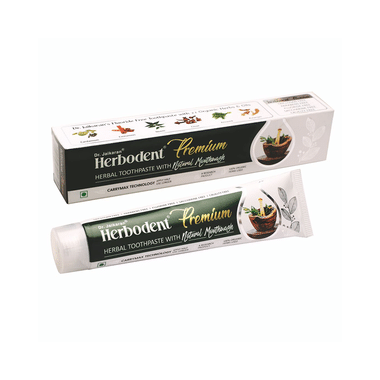Rs. 120
Available in other variants

Product Details
Dr Jaikaran Herbodent Premium Toothpaste contains active natural herbs and provides complete oral care naturally. Herbodent contains natural oral hygiene ingredients like cardamom, cinnamon, clove etc. It prevents dental carries, spongy gum, gum bleeding, pyorrhoea, and bad breath. It is a vegetarian toothpaste and contains no artificial flavours, no chalk powder and no gelatin.
Key Ingredients:
Key Benefits:
Directions for Use:
Safety Information:
Key Ingredients:
- Cardamom, Aniseed, Kulanjan, Clove, Ashok, Bakul, Neem, Tomar, Cinnamon, Giloy, Vaividang, Menthol, Spearmint, Camphor, Thymol, Coriander, Ginger, Eucalyptus, Lemon, Jyotismati, Methyl Salicylate
Key Benefits:
- Herbodent Toothpaste contains active natural herbs
- It provides complete oral care naturally
- Herbodent is full of natural oral hygiene like cardamom, cinnamon, clove etc
- It reduces dental caries, spongy gums, bleeding gums, pyorrhoea and bad breath
- Vegetarian toothpaste which contains no artificial flavours, no chalk powder and no gelatine
Directions for Use:
- Herbodent Toothpaste is typically used for oral hygiene and maintaining the health of your teeth and gums. Here's a step-by-step guide on how to use toothpaste effectively
- Wet your toothbrush: Before applying toothpaste, wet your toothbrush with water. This helps to create a good lather and spread the toothpaste evenly
- Squeeze an appropriate amount: Squeeze a pea-sized amount of toothpaste onto your toothbrush. This is generally sufficient for effective cleaning
- Brush your teeth: Place the toothbrush against your teeth at a 45-degree angle towards the gum line. Start brushing in a gentle, circular motion, covering all surfaces of your teeth—front, back, and chewing surfaces. Make sure to reach all areas, including the inner surfaces of your teeth
- Clean your tongue: After brushing your teeth, you can also use a small amount of toothpaste to brush your tongue. This helps to remove bacteria and freshen your breath
- Spit, but don't rinse immediately: After brushing for about two minutes, spit out the excess toothpaste into the sink. However, avoid rinsing your mouth immediately with water or mouthwash. Leaving a thin layer of toothpaste on your teeth can provide continued protection
- Rinse and clean your toothbrush: After a minute or two, rinse your mouth thoroughly with water to remove any remaining toothpaste. Then, rinse your toothbrush and store it in an upright position to dry
- Avoid eating or drinking: It's recommended to wait for at least 30 minutes after brushing before consuming food or beverages. This allows the fluoride in the toothpaste to continue protecting your teeth
- Brush twice a day: Brushing your teeth with toothpaste should be done at least twice a day—once in the morning and once before bed. This regular practice helps maintain good oral hygiene
- Remember, while toothpaste plays a vital role in oral care, it should be accompanied by proper brushing technique, flossing, and regular visits to the dentist for comprehensive dental care
Safety Information:
- Toothpaste is generally safe to use as directed, but it's important to be aware of certain safety considerations. Here is some safety information regarding toothpaste
- Keep out of reach of children: Toothpaste should be stored in a secure location, away from the reach of young children. Children under the age of 6 should use a pea-sized amount of toothpaste under adult supervision to minimize the risk of swallowing excessive amounts
- Swallowing toothpaste:While it's not intended to be swallowed, small amounts of toothpaste are generally not harmful. However, swallowing large amounts of toothpaste, especially those containing fluoride, can be harmful. Fluoride toxicity can occur if a significant quantity is ingested. If you or someone else swallows a large amount of toothpaste, seek medical attention immediately
- Fluoride content:Many toothpaste contains fluoride, which is beneficial for dental health. However, excessive ingestion of fluoride can lead to a condition called fluorosis, which can cause discolouration or mottling of the teeth. It's important to use toothpaste with the appropriate fluoride concentration for your age group and to use only the recommended amount
- Sensitivity or allergies: Some individuals may experience tooth or gum sensitivity, or even allergic reactions, to certain ingredients in toothpaste. If you develop any adverse reactions, such as irritation, swelling, or rash, discontinue use and consult a dentist or healthcare professional
- Expiration date: Toothpaste, like other personal care products, typically has an expiration date printed on the packaging. Using toothpaste past its expiration date may affect its effectiveness. It's best to discard expired toothpaste and replace it with a fresh tube
- Use as directed: Follow the instructions on the toothpaste packaging for proper use. Avoid using excessive amounts of toothpaste, as this can lead to foaming and may cause unnecessary ingestion of the product
- If you have specific concerns or questions about the safety of a particular toothpaste or its ingredients, it's recommended to consult with a dentist or healthcare professional for personalized advice












